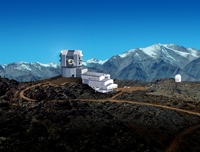Jan 9 2008
Carnegie Mellon University joined the collaboration building the Large Synoptic Survey Telescope (LSST) and is now among the 23 universities, national laboratories and corporations involved in constructing the world's most powerful survey telescope.
 Design of LSST Telescope dome and local facilities. Courtesy of Michael Mullen Design, LSST Corporation
Design of LSST Telescope dome and local facilities. Courtesy of Michael Mullen Design, LSST Corporation
The 8.4-meter LSST is scheduled to begin operations in 2014 atop Cerro Pachon, a mountain in northern Chile. It will survey the entire visible sky deeply in multiple colors each week with a three-billion pixel digital camera. The telescope will take snapshots every 15 seconds, opening a movie-like window on objects that change or move on rapid timescales, such as exploding supernovae and potentially hazardous near-Earth asteroids. The images from the LSST also will be used to trace billions of remote galaxies, measure the distortions in their shapes produced by lumps of dark matter and provide multiple tests of the mysterious dark energy.
"The LSST project is a flagship project in 21st century cosmology," said Fred Gilman, acting dean of the Mellon College of Science and the Buhl Professor of Theoretical Physics. "We are excited to join this ambitious venture and hope to immediately begin contributing to the technical and scientific success of the project."
An interdisciplinary team of researchers from the Mellon College of Science's Department of Physics, the Computer Science Department in the School of Computer Science and the Statistics Department in the College of Humanities and Social Sciences plan to work on the LSST.
The project will result in one of the largest publicly available databases ever to be assembled. Working with the University of Pittsburgh, which has been a member of LSST since July 2007, and the Pittsburgh Supercomputing Center - a joint project of Carnegie Mellon and Pitt - Carnegie Mellon hopes to contribute especially to the acquisition, storage and analysis of LSST data.
LSST is a public-private partnership. Design and development activity is supported in part by the National Science Foundation and the National Optical Astronomy Observatory via the Association of Universities for Research in Astronomy. It was announced Jan. 3 that Charles Simonyi and Bill Gates had together donated $30 million to fund construction of the LSST's three large mirrors.